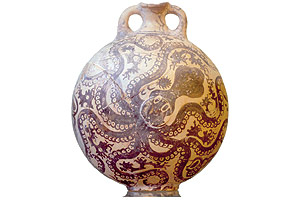Cretan social and political organization revolved around the palace directed by a king. It is not clear if he was regarded as divine or just a servant of divinity. However, we know he held power both as a Monarch and as a religious leader. The Monarchy was bureaucratic and centralized, although not absolute.
Palaces were organized into different sections: public, private, military, workshops, etc. all distributed around a Central Court. Some of these sections were also used to store food and agricultural surpluses, others for religious ceremonies and others to impart justice. The palace served as the residence of Kings and officials, and as a workshop for artisans, among many other purposes.
Some palaces, like in Knossos and Phaistos, had paved streets and, in the former, there was hot water distributed through pipes, a drainage system and sewers. The intricate distribution of the palaces was very much like real labyrinths, a feature which is thought to have given birth to the legend of the Minotaur.
The most famous of the Minoan Kings, whose symbol was the double axe, was King Minos. However, the man is mixed with legend. He was believed to be the son of Zeus and Europa. He is also supposed to have ruled three generations before the Trojan War and, moreover, he is believed to have created the Cretan Constitution and to be behind the growth of Crete’s sea power.
Authors, however, have still to agree if Minos is the denomination for a King, a Dynasty or some high position.
Women possessed great freedom in Minoan society. In fact, they could participate in the games that were practiced in the island just as men could or in theatrical plays, whereas in other cultures that shared Asian or Indo – European influence in the same period, women were absolutely subjugated to men. Although we know there were priests and a nobility, and that their numbers were high, not much is known of the rest of the social classes, which were, supposedly, varied.
Archeological findings show a society that enjoyed life, with festive celebrations where luxuries were available which were prohibited for other communities at the time.
Feminist Religion
Cretan Religion was devoted to fertility and fecundity, represented by feminine figures whose forms symbolized the earth’s generosity. The great deity, Potnia, originated in rites from the Neolithic Period. She was the goddess of nature and many animals and objects were related to her. Asian influence on Cretan religion is perceptible in figures with male or female bodies but the heads of animals, such as the Minotaur of winged sphinxes. The cult to the great mother of Asia Minor is represented in various forms, be it accompanied with snakes, lions and doves, or dressed as a warrior or on a ship to protect navigation. She also had power over the underworld or Hell.
Rites in Minoan religion took place in natural sanctuaries, mainly grottos, caves or mountain tops, where gods were offered wine, honey or olive oil. Temples were scarce.
Many famous myths take place in Crete. Such as the case of the Legend of the Minotaur, a monster with a bull’s head and a man’s body. Minos had received a great white bull from Poseidon as a gift. When Minos, awed by the animal’s beauty, refused to sacrifice it in honour of the god, Poseidon made Minos’ wife, Pasiphae fall in love with the bull. The Minotaur was the born from this love. Minos then commanded architect and inventor Daedalus to build a labyrinth impossible to exit without help. The Minotaur was locked inside. Another legend related with the labyrinth is about Daedalus and his son Icarus, whom Minos locked inside the intricate building. Daedalus made wax wings for his son and himself, with which they flew out of the labyrinth. But Icarus flew too close to the sun, his wings melted, and he fell into the sea and drowned.
Minoan Art
The main expressions of Minoan art on the Island of Crete are found in the palaces. Painting is essentially decorative and its forms are very stylized, with colours which usually do not correspond with reality.
The frescos betray Egyptian influence in the drawings, which lack perspective. Recurrent themes are marine fauna (dolphins, for example), courtesan life, together with scenes depicting Tauromachy. Minoan painters were also famous for polychrome reliefs.
Ceramics was another art where Cretans were renown for making very refined pieces and inventing new forms, such as rythons or libation cups (to honor the gods) and amphoras (ancient vases).
They also experimented with a new form of decoration, particularly in the Camares Vases, where colour was associated with octopus figures, giving the sensation of constant movement.
Minoan artisans also produced silver and gold work. They made beautiful jewels and other similar objects resorting to the great knowledge they possessed in the techniques of metallurgy.
A common peculiar trait in the Cretan arts is the absence of themes related to warfare, a fact that supports the thesis that this was a peaceful people.








